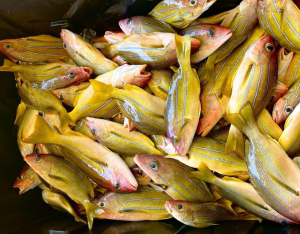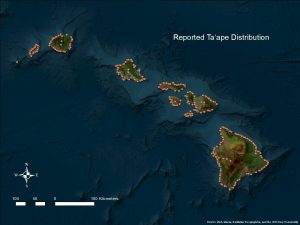Ta’ape
Ta’ape (Lutjanus kasmira)
Description:
- Yellow snapper with 4 blue horizontal lines across the lateral side of the fish
- Matures between 20-25 cm in length (Allen 1985)
Habitat:
- Found in coral reefs, in shallow lagoons, and outer reef slopes (Allen 1985)
Impacts & Concern:
- Taʻape is not as desired by fishermen as other snappers, which allows the population to grow (Parrish et al., 2000)
- It is an introduced species not native to the Hawaiian Islands (Parrish et a.,l 2000)
- Spreads rapidly throughout the Hawaiian Islands at various depths (Parrish et al., 2000)
- There is not a predator that prefers taʻape (Radway, 2014)
- Could act as a vector for parasites (Brown et al., 2023)
- The over-abundant population can occupy habitat space and create competition for space with native species
Introduction:
- First found in Hawaiʻi in 1955 (Allen, 1985)
- Stocked by the Hawaiʻi Division of Fish and Game intentionally from French Polynesia (Parrish et al., 2000)
Distribution in Hawaiʻi:
Established throughout the main Hawaiian Islands (Brown et al., 2023)
- Kauai: Present
- Oʻahu: Present
- Molokai: Present
- Lanai: Present
- Maui: Present
- Big Island: Present
Related AIS Team Management Projects:
- The Division of Aquatic Resources held a Taʻape Fishing Tournament on the Island of Kauai in 2023. Local community members participated in a 24-hour fishing tournament, during which multiple prizes were awarded for the heaviest fish and total catch weight. Participants could also learn and watch local Chef Mark Oyama of Mark’s Place Restaurant and Contemporary Flavors Cuisine fry the Taʻape and promote the consumption of this delicious fish.
News:
- https://www.forbes.com/sites/sarahburchard/2021/12/10/hawaiis-fish-for-the-future/?sh=5391b8585558
- https://www.hawaiinewsnow.com/2023/06/30/kona-tournament-helps-clear-invasive-reef-fish/
Regulations:
- Prohibited for import, not currently listed under HDOA import rules (§4-71-6.5)
References:
- Allen, G.R. 1985. FAO Species Catalogue. Vol 6. Snappers of the World. An annotated and illustrated catalogue of lutjanid species known to date. FAO Fisheries Synopsis No. 125. Food and Agriculture Organization of the United Nations, Rome.
- Brown, M., Fuller, P., and Gregoire-Lucente, D. R., 2023, Lutjanus kasmira (Forsskål, 1775): U.S. Geological Survey, Nonindigenous Aquatic Species Database, Gainesville, FL, https://nas.er.usgs.gov/queries/FactSheet.aspx?SpeciesID=774, Revision Date: 9/19/2023, Peer Review Date: 9/17/2015, Access Date: 10/9/2023
- Mary Brown, Pam Fuller, and Denise R. Gregoire-Lucente, 2023, Lutjanus kasmira (Forsskål, 1775): U.S. Geological Survey, Nonindigenous Aquatic Species Database, Gainesville, FL, https://nas.er.usgs.gov/queries/FactSheet.aspx?SpeciesID=774, Revision Date: 9/19/2023, Peer Review Date: 9/17/2015, Access Date: 11/15/2023
- Parrish, J. D.; Aeby, G. S.; Conklin, E. J.; Ivey, G. L.; Schumacher, B. D. 2000. Interactions of Nonindigenous Blueline Snapper (Taʻape) with Native Fishery Species. State of Hawaii Department of Land and Natural Resources Division of Aquatic Resources. https://dlnr.hawaii.gov/dar/files/2014/04/TaapeInteractions.pdf

